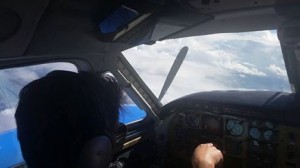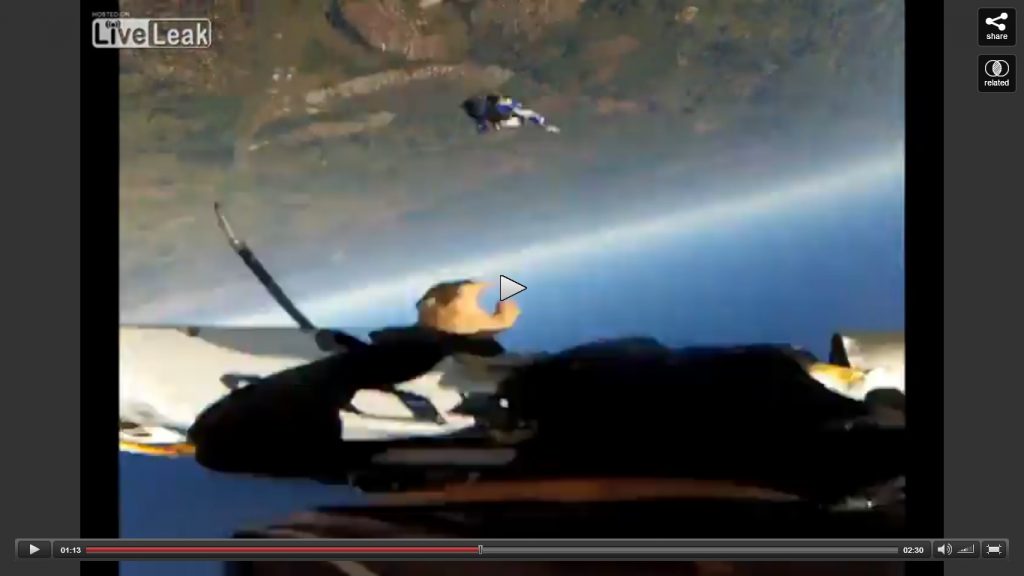Many thanks to Bryan for letting me copy his article and the great people out at Skydive Arizona in Eloy, AZ
By Bryan Burke, S&TA at Skydive Arizona

Identifying the Problem
All of the following events took place during our spring 2013 season here at Skydive Arizona. Some have been repeated several times. Since I started to look into this subject and inquire as to what other drop zones are seeing, several similar incidents have been brought to my attention. In addition, there are several reports of serious freefall collisions that have resulted from tracking, angle, and wingsuit dives around the world.
Example One Angle flying dives, also known as atmonauti or tracing dives, are recording fall rates comparable to freeflyers. They not only fall faster than true trackers, they do not cover nearly the horizontal distance that true tracking dives do. (Inexperienced trackers, especially on their backs, often have essentially the same flight characteristics, much faster down than experienced trackers and not much horizontal travel.) In one case, a group of very experienced angle fliers insisted on exiting first, saying they were trackers. They fell at freefly speeds, about 170 miles per hour. The dive was planned to go roughly 90 degrees to the line of flight, but they didn’t go very far, covering less than half the distance a real tracking dive would. This type of dive tends to include a lot of highly experienced freeflyers experimenting with new stuff, so they were jumping very fast canopies and opening between 3,000 and 3,500.
A conventional belly flying group followed them out. They had a long climb-out, about 15 seconds, broke off at 4,500 feet, tracked, and deployed between 3,000 and 2,500. All of them were experienced and competent trackers in the conventional sense of the word.
There was nothing unusual about the conditions. Up on the jump run, the airplane was covering ground at 150 feet per second (about 90 knots) and the horizontal distance between Group 1 and Group 2 at exit would be about 2,250 feet. Because of the longer freefall time for the second group, about 500 feet of that was lost to freefall drift in the winds aloft. This leaves their hypothetical center points at opening about 1,750 horizontal feet apart, still adequate separation for two conventional belly flying groups opening within a few seconds of each other.
However, because of their fast freefall speed, followed by the climb-out time for the second group, the angle fliers deployed their parachutes nearly thirty seconds before the second group, but also 500 to 1,000 feet higher. They immediately turned towards the landing area under canopy; otherwise they would not get back, at least not with enough altitude for a big swoop. During that thirty seconds, they only dropped about 700 – 1,000 feet or so vertically, but they covered between 1,500 and 1,800 horizontal feet in that time. This does not even take into account the ground covered by tracking at break-off from either group.
Canopy winds were light. In thirty seconds, a modern fast canopy in normal straight flight will do 60 feet per second horizontally. That puts them 1,800 feet back towards the DZ and line of flight. Mentally, skydivers tend to think freefall separation is an exit problem, not a canopy problem. Once they have a good canopy, they are conditioned to think about canopy traffic and their landing – not about what might be in freefall overhead, because in the past this has not been a problem since we figured out that fast fallers should follow slow fallers out in the exit sequence.
So, at about 2,500 feet the two groups effectively merged into a single large mix of deploying freefallers and people already under very fast parachutes. The only reason there were no collisions was blind luck. Mind you, every one of these jumpers was experienced, current, and well trained within the existing paradigm.
Example Two A very experienced jumper with a cutting edge wingsuit was logging freefalls of over three minutes and opening at about 3,500. We had three aircraft flying. Our procedure is to leave a minimum of two minutes between drops for conventional freefall loads, three with wing suits or students, and four after a load with tandems. The wingsuit jumper exited. The plane behind started a three minute clock. Although the wingsuiter opened about half a mile away from the jump run, he then made a riser turn towards the landing area and left the brakes stowed as he fiddled with his suit. A minute later, he was just under 2,500 when canopies were opening around him.
Example Three Taxiing out from the loading area, the pilot called me to ask which way trackers should go. This piqued my curiosity, trackers are supposed to know this when they manifest. I told him “east” and asked if he could tell where they were in the exit order. Meanwhile I checked with the manifest to see if anyone on that load had reported they were planning to track or asked for information about which way to go. None had. A bit later the pilot replied that they would be exiting first. I got out my binoculars to watch.
The three-way tracking group exited and flew straight up the line of flight, opening between the next two groups in the exit order. Naturally I noted their canopies and rounded the three up in the landing area for a discussion. Initially they were confused about what the problem was, although they did acknowledge that there were other canopies in the sky closer than they had expected.
The leader of the dive had seventy jumps. It was his first tracking dive, and he was leading it on his back. He had planned to turn off jump run and fly east and was completely unaware of his failure to do so. The other two had about 150 and 200 jumps, not enough to be aware that he had failed to turn. Even if they had been, there was no plan on how to signal course corrections to the leader, and they were not close enough to do so in any case, due to the lack of experience. Two of the three, including the one with 70 jumps, had GoPros on, which no doubt distracted them from the navigation problem as they tried to video each other. It was a de-briefing nightmare as I learned more and more about how much they did not know. It was their first time at a large, busy drop zone. They had never received any coaching or advice on tracking. They had no idea about USPA’s recommendations for jumping with a camera.
This episode made me realized that the manifest in-briefing that had served us well for years, with minor modifications now and then, was no longer adequate. In the past we never felt the need to screen for camera use or horizontal flying, merely informing them that if they were planning to track or wingsuit they would need to get a daily update from the safety officer.
Example Four A total of twelve wingsuit jumpers landed out, the nearest almost half a mile from our normal landing area, the farthest over a mile out. After I rounded up the entire group (not one of them local jumpers) I made it plain that this was unacceptable, not just from a safety point of view, but also because many of them landed on private property or public roads, not a good thing in terms of our relations with the community. Questioning them about their flight planning, I learned some very interesting things. First, it was two groups, not one. The less experienced group was planning to take an “inside track” while the second, more experienced group was planning to fly a wider course, both of the tracks parallel to the original jump run. (This is a fairly common practice at DZs with a lot of wingsuit activity.)
To make this easier, the individual who had taken charge of planning asked the pilot to turn 90 left at the end of the regular skydiver jump run. In theory the two wing suit groups would then simply exit and turn 90 left, paralleling the normal jump run back to the DZ and gaining horizontal separation from the climb-out time on jump run.
Unfortunately this plan did not take into account that the winds aloft were about 30 knots out of the west, and the standard jump run was south. Thus, a left turn gave the plane a ground speed of about 130 knots, and each group took quite a while to climb out. Once in flight, they were already well down wind of the planned flight area and would have more cross-wind push the entire flight.
Clearly this plan was doomed from the start, and anyone who had the slightest idea what the winds aloft were doing would know this. Winds aloft are very easy to find on line these days, or someone could have simply asked the Safety Officer what his observations were. Not one of those twelve wingsuiters questioned the incredibly bad plan the group leader had come up with, which was based on completely wrong assumptions. Even if anyone had looked down, they were already committed and had no Plan B.
Example Five I picked up a wingsuit jumper who landed over a mile off the dz. (Nearly 1.5 statute miles, in fact.) The only reason I even knew about him was a bystander saw his canopy in the distance and pointed him out. I never would have seen him, his opening point was well beyond our first exit group on the normal jump run! His story? With very little experience on his new high performance suit, he was jumping a new helmet and camera set-up for the first time. He reported that he had problems with the helmet throughout the flight (shifting and vibrating) and forgot to pay attention to where he was going, flying downwind and away from the DZ the entire time.
Example Six Trackers landed out, on the approach to the runway. When I inquired about the flight plan they said that when they got to the airplane, there was another tracking dive. The two groups decided to exit first and second, each going 90 degrees to the jump run in opposite directions. This put the out-landing group exiting at the extreme early end of the jump run, tracking downwind, then faced with penetrating back into the canopy winds. They had no chance to make it to the normal landing area and their opening position put them in a canopy descent to a clear area directly on the extended centerline of the runway.
These are real world examples at one drop zone over the course of a mere couple of months. Along with similar problems reported from other drop zones and the incidents of actual and near-miss collisions associated with horizontal dives, it seems clear that training in these fields is completely inadequate.
Before Freeflying came along in the early 90s, the skydiving environment was very simple. Everyone fell almost straight down and parachutes flew about 25 miles per hour. In the 90s, we had to figure out how to deal with a new, much faster fall rate in some groups, and canopies almost doubled in horizontal speed. In the last decade, even more variations in skydiving have popped up. These didn’t really show up much on DZO’s radar because so few people were doing them, but now they are increasingly common.
Approximate Speeds of Various Forms of Skydiving Activity*
| Activity |
Vertical Speed Range |
Horizontal Speed Range |
Freefall time (13,000) |
| FS |
120 – 130 mph |
0 – 20 mph** |
00:60 – 65 |
| Freefly |
150 – 180 |
0 – 20** |
00:40 – 50 |
| Tracking |
120 – 140 |
30 – 60*** |
00:55 – 65 |
| Angle |
140 – 160 |
20 – 40*** |
00:45 – 50 |
| Wingsuit |
40 – 70 |
50 – 80*** |
01:30 – 3:00 |
*Approximations derived from videos and recording altimeters. **Random drift due to things like backsliding, one side of the formation low, etc. ***Best guess, based on distance covered in freefall time.
Thus, on a single load there might be freefall times from exit at 13,000’ to opening at 3,000’ as little as :40 seconds and as much as three minutes. Horizontal speeds will range from zero to 80, with distances of up to a mile on tracking dives and flights of several miles possible for expert wingsuit jumpers. Note that these speeds will vary considerably. For example, experimenting with tracking myself and observing tracking contests, I could get well over a mile in 60 seconds and many people can out-track me by a significant margin. However, actual tracking dives are usually not done in a max track position because it doesn’t lend itself to maneuvering with others. On a calm day, a tracking dive going 90 off the line of flight usually only covers about half a mile.
Identifying the Risks
Collisions within Groups Within groups, tracking, wingsuit, and angle dives are showing a disproportionately high rate of collision injuries. Even the best planned dives can still involve high closing speeds as the group forms and breaks up. And, as Bill von Novak has pointed out:
On a tracking dive there is no focal point; no base you can dock on or, failing that, at least keep in sight for break-off. Everyone tracks in effectively a random direction at the end of the dive and hopes for clear air. In some cases they even barrel roll just to add some more randomness to their directions. To a newbie a tracking dive sounds lower pressure than a big-way; you don’t have to dock, you just have to go in a similar direction as the leader. This tends to attract lower experienced jumpers, and those jumpers often shed the jumpsuit they are used to for a freefly suit or no suit at all – resulting in new and hard to predict fall rates/forward speeds.
To that I have to add the potential for huge closing speeds, sometimes due to lack of skill but often due to poor organizing. Tracking dives in particular have a history of being “loose” or “pick-up” loads. Many times I have seen people “organizing” a tracking dive by making a general announcement to give a ticket to manifest if you want to come along. There is often very little screening for experience and ability.
Then, it is common to group the more experienced people close to the leader, and that person is often in a floater position on exit. Anyone who can remember learning to do larger formations knows that novice divers tend to dive too long, even if they have been forewarned about the problem. (If you dive out two or three seconds after the base, that base is way ahead of you on the acceleration curve, so they appear to be getting further away – which they are. You dive more aggressively, something you don’t have much practice at. Then, when the base hits terminal velocity, they suddenly rush up at you because you are now going much, much faster than the base. You then go low, or collide.)
Now add to that the significant horizontal movement, burbles that aren’t directly above the lower jumper, multiple vertical levels, and huge blind spots since you are looking ahead, not around. The potential for collisions is incredibly obvious once you think about it, but apparently few people doing tracking dives are thinking about it.
Collisions Between Groups Although these are still rarely found in the accident record, I have seen many near misses, which suggests that it is only a matter of time. This is particularly disturbing to me because in a group-to-group collision, it means someone was exposed to an extreme hazard that they had no knowledge of, expectation of, or control over. Skydiving is risky enough with the known hazards. As drop zone operators and safety professionals it is morally wrong to expose our customers to a risk where their only real control would be to look at who else is on the load, and pull off it.
Landing Out Out landings have two problems, one a risk to the jumper and the other, to the drop zone itself. The record shows that out landings have a high risk of landing injuries, especially from low turns to avoid obstacles or turn into the wind. This risk is exacerbated by the fact that the drop zone staff might not even know of an injury, and if they do, the response can be complicated.
The second risk is aggravating the neighbors or airport authorities. Every drop zone has at least some neighbors or authorities who are opposed to skydiving. As long as these are a small minority a DZ can usually get by. Once skydivers start dropping into neighborhoods, landing on runways, and otherwise drawing unwelcome attention, the political balance can change. A classic example of this is the tracker landing on the roof of a two-story house 1.3 miles south of the DZ at Longmont, Colorado early in July of 2013. He not only broke his leg, he damaged the roof and required a complex rescue. At the time of the incident, he had 64 jumps in over a year in the sport. The wind was blowing from the north, but he tracked south, towards a heavily developed suburban area. In his own remarks, he accepts no responsibility for the incident, blaming it entirely on the winds rather than his extremely poor planning.
Changing the Paradigm What do these activities all have in common, from the standpoint of skydiving culture? There is very little expectation, or even definition, of quality. Success is defined as mere participation and survival. Near collisions, actual col







